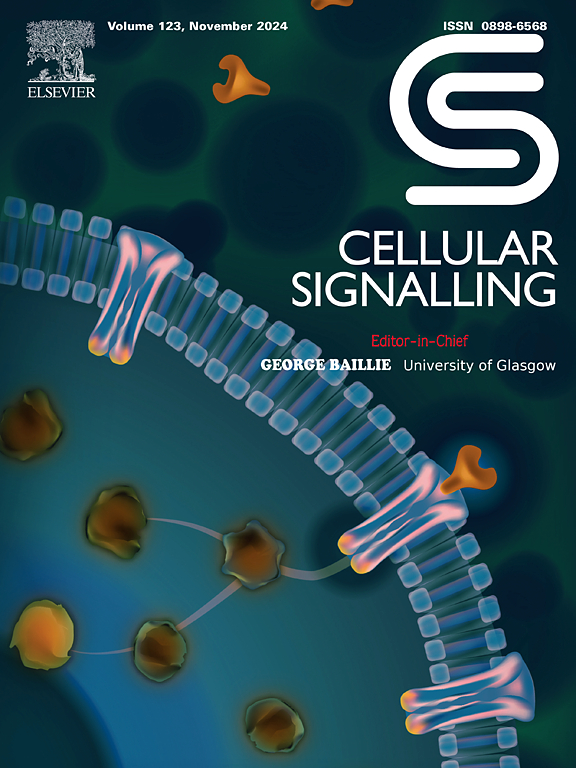METTL14-mediated m6A modification of TRPA1 promotes acute visceral pain induced by uterine cervical dilation by promoting NR2B phosphorylation
IF 4.4
2区 生物学
Q2 CELL BIOLOGY
引用次数: 0
Abstract
Background
While TRPA1 serves as a therapeutic target for nociceptive pain, its role in acute visceral pain induced by uterine cervical dilation (UCD) remains an enigma. This study aims to elucidate the upstream and downstream mechanisms of TRPA1 in the context of UCD-induced acute visceral pain.
Methods
The UCD rats were administered with SAH (inhibitor of the METTL3-METTL14 complex) via intrathecal tubing. Validate UCD model by measuring spinal c-Fos expression and EMG. The levels of TRPA1 and p-NR2B were evaluated by qRT-PCR and western blot,and m6A level was detected by the kit. RNA Immunoprecipitation was adopted to determine the binding between TRPA1 and METTL14. Neurons were isolated from rat dorsal root ganglia (DRG), exposed to SAH treatment, and subsequently subjected to actinomycin D experiments.
Results
In the UCD model, cervical dilation causes an increase in EMG signal and spinal cord c-Fos expression. At the same time, the levels of TRPA1, p-NR2B, METTL14, and m6A increased in a stimulus intensity-dependent manner. Intrathecal SAH, a METTL3-METTL14 inhibitor, alleviated UCD-induced pain and reversed above indicators. Further investigation revealed that METTL14 binds to TRPA1, increasing TRPA1 mRNA stability via m6A modification.
Conclusion
METTL14 stabilizes TRPA1 through m6A modification, thereby promoting NR2B phosphorylation, culminating in acute visceral pain induced by UCD.
mettl14介导的m6A修饰TRPA1通过促进NR2B磷酸化促进宫颈扩张引起的急性内脏痛。
背景:虽然TRPA1是痛觉性疼痛的治疗靶点,但其在宫颈扩张(UCD)引起的急性内脏痛中的作用仍然是一个谜。本研究旨在阐明TRPA1在ucd诱导的急性内脏疼痛中的上下游机制。方法:将METTL3-METTL14复合物抑制剂SAH经鞘内插管给予UCD大鼠。通过测量脊髓c-Fos表达和肌电图验证UCD模型。采用qRT-PCR和western blot检测TRPA1和p-NR2B水平,试剂盒检测m6A水平。采用RNA免疫沉淀法测定TRPA1与METTL14的结合情况。从大鼠背根神经节(DRG)中分离神经元,经SAH处理后进行放线菌素D实验。结果:在UCD模型中,宫颈扩张引起肌电图信号和脊髓c-Fos表达增加。同时,TRPA1、p-NR2B、METTL14、m6A水平呈刺激强度依赖性升高。鞘内SAH是一种METTL3-METTL14抑制剂,可减轻ucd诱导的疼痛,逆转上述指标。进一步研究发现,METTL14与TRPA1结合,通过m6A修饰提高TRPA1 mRNA的稳定性。结论:METTL14通过m6A修饰稳定TRPA1,从而促进NR2B磷酸化,最终导致UCD诱导的急性内脏痛。
本文章由计算机程序翻译,如有差异,请以英文原文为准。
求助全文
约1分钟内获得全文
求助全文
来源期刊

Cellular signalling
生物-细胞生物学
CiteScore
8.40
自引率
0.00%
发文量
250
审稿时长
27 days
期刊介绍:
Cellular Signalling publishes original research describing fundamental and clinical findings on the mechanisms, actions and structural components of cellular signalling systems in vitro and in vivo.
Cellular Signalling aims at full length research papers defining signalling systems ranging from microorganisms to cells, tissues and higher organisms.
 求助内容:
求助内容: 应助结果提醒方式:
应助结果提醒方式:


